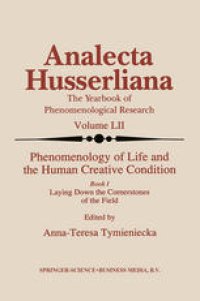
Ebook: Phenomenology of Life and the Human Creative Condition: Book I Laying Down the Cornerstones of the Field
- Tags: Phenomenology, Philosophy of Science, Philosophy of Mind
- Series: Analecta Husserliana 52
- Year: 1998
- Publisher: Springer Netherlands
- Edition: 1
- Language: English
- pdf
Self-individualization has been interpreted as the process in which the all-embracing Self unfolds into an infinite variety of different individ uals, plants, animals and men. A comparison of the different ways in which the Self manifests itself in the biological and psychological devel opmental processes, or in a visionary image of the undivided Self, reveals the same basic structure of expression. The Self, the one, is represented by a circular domain, and comprises a basic inner duality, the two, creating a paradox of conflicting opposites. In the undivided Self the two give rise to a trinity in which, however, a quatemity is hidden. The latter expresses itself in this world as the four basic forces, the four Elements or the four main archetypes, specifying the possibilities or development in space and time. Self-individualization starts with the first appearance of a primary structure of an individual sub-Self. This is the fifth basic force, the fifth Element. Further development is character ized by four generative principles: 1st, the principle of wholeness: connection and integration (being oriented to remaining whole or restoring wholeness); 2nd, the principle of complementarity and com pensation (a periodic shift between opposing influences); 3rd, the enstructuring principle (causing the relative stability of the spatial appear ance of the manifest structure), and 4th, the principle of gesture (resulting in a gradual stepwise development of that structure into a full-grown individual).
There is a new rhythm permeating phenomenology, which is re-orienting towards the ontopoiesis of life. There are inflated views abroad that phenomenology has lost its identity and it is fashionable to consider that philosophy has abandoned the `pursuit of truth', which is dismissed as illusory. But the phenomenological philosophy here reincarnated as the phenomenology of life and the human creativecondition vibrates with a fresh philosophical faith. The present volume articulates the four main tenets of the ontopoiesis of life: first, the priority of the creative act over the cognitive intentional act; second, the revelation that the Human Creative Condition is pivotal in tracing specifically human powers; third, that the creative act of the human being is the meeting ground for all human endeavours; and fourth, the ontopoietic self-individualisation of life.